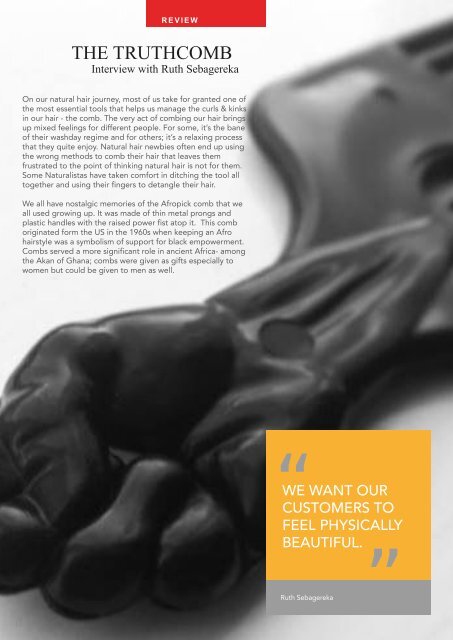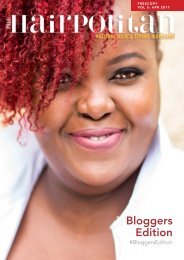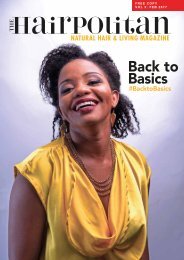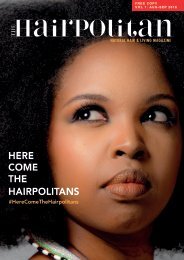Hairpolitan Magazine Vol 2 Oct-Nov 2016
African Esteem means that if you decide for yourself that you are beautiful, you must be. If you decide to be yourself, then that is beauty in its quintessential form and no one can take that truth away from you.
African Esteem means that if you decide for yourself that you are beautiful, you must be. If you decide to be yourself, then that is beauty in its quintessential form and no one can take that truth away from you.
You also want an ePaper? Increase the reach of your titles
YUMPU automatically turns print PDFs into web optimized ePapers that Google loves.
REVIEW<br />
THE TRUTHCOMB<br />
Interview with Ruth Sebagereka<br />
On our natural hair journey, most of us take for granted one of<br />
the most essential tools that helps us manage the curls & kinks<br />
in our hair - the comb. The very act of combing our hair brings<br />
up mixed feelings for different people. For some, it’s the bane<br />
of their washday regime and for others; it’s a relaxing process<br />
that they quite enjoy. Natural hair newbies often end up using<br />
the wrong methods to comb their hair that leaves them<br />
frustrated to the point of thinking natural hair is not for them.<br />
Some Naturalistas have taken comfort in ditching the tool all<br />
together and using their fingers to detangle their hair.<br />
We all have nostalgic memories of the Afropick comb that we<br />
all used growing up. It was made of thin metal prongs and<br />
plastic handles with the raised power fist atop it. This comb<br />
originated form the US in the 1960s when keeping an Afro<br />
hairstyle was a symbolism of support for black empowerment.<br />
Combs served a more significant role in ancient Africa- among<br />
the Akan of Ghana; combs were given as gifts especially to<br />
women but could be given to men as well.<br />
“<br />
WE WANT OUR<br />
CUSTOMERS TO<br />
FEEL PHYSICALLY<br />
BEAUTIFUL.<br />
“<br />
The handles were decorated with motifs that had a<br />
message. For example, husbands would give wives<br />
combs that symbolized fertility in the hopes of the<br />
woman bringing forth healthy children. The Yaka<br />
people, from the Democratic Republic of Congo,<br />
wore combs that had elaborately designed<br />
headrests and human figures symbolizing the<br />
wearers’ status and group affiliation.<br />
Ancient combs were made from natural materials<br />
such as wood, bamboo, ivory or bone. The material<br />
used, determined if the comb was for daily use or<br />
for prestige purposes. Sometimes one comb served<br />
both utilitarian and decorative purposes. In modern<br />
times, our combs are purely utilitarian and most are<br />
made mostly from plastic with a majority imported<br />
from countries, such as China, that don’t understand<br />
the nature of our hair. It’s a little bit sad that we are<br />
not interested in understanding and creating a tool<br />
that would work for our own hair. This is all set to<br />
change, so must not lose hope.<br />
Introducing Ruth Sebagereka, a bonafide Naturalista<br />
and a groundbreaking innovator of the Truthcomb.<br />
While on her natural hair journey, and in a bid to get<br />
her hair to a manageable state, it dawned on her<br />
that God did not give her hair she could not handle.<br />
She therefore decided to investigate the hair care<br />
and management regimes that she was undertaking.<br />
Ruth discovered that if all remained constant, the<br />
comb and/or combing technique, was the only thing<br />
remaining that needed adjusting.<br />
She calls her invention the Truthcomb because she<br />
wants us to know the truth about our hair.<br />
“The Truthcomb promises to take care of your curly<br />
hair in the way which is best aligned to bring out the<br />
beauty of your curly hair,” says Ruth. “We want our<br />
customers to feel physically beautiful. We want to<br />
tell them the truth about the hair- that they were<br />
created with such beautiful hair, it’s transcendent.”<br />
Truthcomb Model 001<br />
Ruth Sebagereka - Truthcomb Inventor<br />
The comb is the first of its kind globally that does<br />
what it does. It works on the premise that African<br />
hair grows parallel to the scalp, “This is a<br />
fundamental premise that needs to be preserved<br />
when grooming.” Ruth clarifies. The comb travels<br />
horizontally through the hair as it is stacked in layers<br />
and also staggered which helps smooth down the<br />
cuticles along each individual hair strand. The trick<br />
to using the Truthcomb is the ratio of comb to hair;<br />
you are required to section and groom only a little<br />
bit of hair at a time.<br />
Truthcomb Model 001 has 273 bristles with 7 layers.<br />
It is anti-static and has a light detachable handle.<br />
Over time, one can change the head of the comb to<br />
suit their hair needs, as the comb will work for all<br />
lengths and types of hair. The company plans to<br />
launch only the short hair model for now. The comb<br />
will be initially available online and shall target all<br />
curly hair markets in the world.<br />
Ruth aims to contribute to the innovation and<br />
manufacturing sector in Africa. She is working with<br />
various stakeholders. She confesses that she has not<br />
created the Truthcomb alone and is grateful to all<br />
those who have supported her and have helped in<br />
many miraculous ways. “So we are fundamentally<br />
committed to traveling this journey of innovation<br />
with others,” she affirms.<br />
Her challenge to potential innovators is to see how<br />
to “have a firm foundation upon which to effect<br />
change in current day Africa. That is, to present<br />
the historical precedence of excellence so as to<br />
achieve excellence in our own times. If we believe<br />
in our historical greatness- we can then do great<br />
things. But first, I must live it!”<br />
Ruth Sebagereka<br />
10<br />
11








